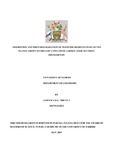Adsorption and photodegradation of pesticide residues in selected plants grown in organic container garden: food security phenomenon
Abstract
This work focuses on the fate of pesticide residues mainly; pentachlorophenol, lambda
cyhalothrin, chlorothalonil and chlorpyrifos in organic container farming in soil and crop
surfaces. Adsorption of pesticide residues, photo-degradation of pesticide residues by light,
pesticide levels in various crops and methods of removal have been discussed.
Food insecurity in the world has led to improvement of farming methods to modern and
more sustainable methods which require less rainfall, land and agricultural inputs. These
methods translate to high yields and shorter time to crop maturity. Organic container gardening
methods is practical in areas where land is scarce, for example in slums and therefore has been
adopted by some slum dwellers. Most farmers, who practice this type of farming, grow
vegetables, maize, beans and nappier grass in sacks, plastic bags, flower vases and plastic
containers. Questionnaire administered to farmers revealed that 70% have prior knowledge of
organic farming. Most of them said they did not wash their produce before use or selling. 78% of
the interviewed people do not know where the produce they eat/use come from. Some farmers
admitted to applying pesticides in their farms.
The adsorption phenomenon of chlorpyrifos by loam soil particles where the crops were
grown in an aqueous solution was studied using a Freundlich isotherm model which assumes the
adsorption/ desorption relations: nX + S ⇔ SX n , K = [ SX n ] / [ X ]n [ S ]
and ln[x]ads =ln (nK’) +
nln[x]e + [sxn]w, where
is the chemical species of interest; S is the substrate; is the
adsorption/desorption equilibrium constant; is the particle-pesticide complex. The apparent
adsorption equilibrium constant; []ads is concentration of in adsorbed state in water suspension.
[]e is the concentration of in solution at equilibrium and []w is the pesticide adsorption site
complex in the suspension at equilibrium. The amount of chlorpyrifos adsorbed was determined
against variation of mass of sediment, concentration of chlorpyrifos and contact time using UVVisible
spectrophotometer at 254nm. 89-99.1% of chlorpyrifos molecules were adsorbed
regardless contact time with the process equilibrating after 30 minutes. The data obtained in this
study best fitted the quasi Langmuir adsorption isotherm with regression values of up to 0.992.
The calculated values of the apparent K, n and ∆G were found to be 118.665, 0.244 and 11.7946kj/mol.
The negative value for ∆G confirmed the fact that adsorption reaction occurs
spontaneously. Moreover, adsorption of chlorpyrifos onto suspended/dissolved sediment
particles decreased with increase in mass of the substrate and variation of concentration.
Photo degradation of pentachlorophenol, lambda cyhalothrin, chlorothalonil and
chlorpyrifos by sunlight, 40w, 60w, 75w and 100w light bulbs on the surface of spinach and
tomatoes was also studied. The results obtained indicated that up to 84% pentachlorophenol,
71% chlorpyrifos, 72% lambda cyhalothrin and 85% chlorothalonil degraded on the surface of
spinach on exposure to 100w bulb for 60 minutes. Photo-degradation of these residues was found
to be dependent on temperature, time of exposure, light intensity and surface of exposure.
Analysis of pentachlorophenol, lambda cyhalothrin, chlorothalonil and chlorpyrifos on
tomatoes, potatoes and spinach from organic container garden was also studied. Extraction was
done using AOAC 2007.01 method without cleanup step. The samples were analyzed using
reversed phase high pressure liquid chromatography. The results indicated presence of
significant levels of chlorothalonil, pentachlorophenol and chlorpyrifos in spinach and high
levels of PCP in both tomatoes and potatoes. Pentachlorophenol (PCP) levels exceeded CODEX
limits by 26.47, 89.13 and 44.44 % in spinach, tomatoes and potatoes, respectively, while
chlorothalonil and chlorpyrifos in spinach exceeded MRL levels by 20.00 and 28.57 %,
respectively.
Spinach and tomatoes were washed with; 0.9% NaCl, 0.1% NaHCO3, 0.001% KMnO4,
tap water and 0.1% acetic acid before extraction and analyzed with the UV-Vis
spectrophotometer. For the washing solution treatments, 0.001 % KMnO4 washing solution was
found to be most effective in reducing the pesticide residues which was most probably due to the
high degree in the pesticide degradation.
Key words: Pesticide Residue, Organic Container Gardening Vegetables, Quechers,
Adsorption, Photo-Degradation.
Publisher
University of Nairobi
Description
Thesis

